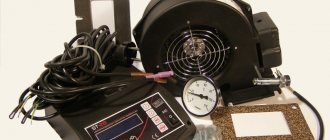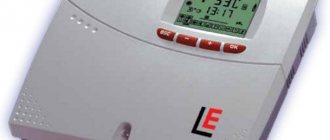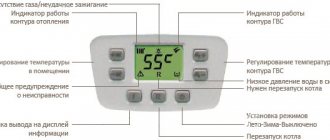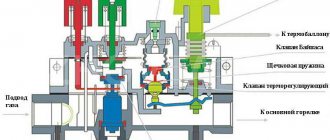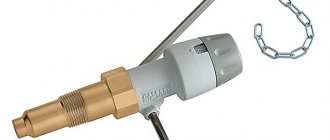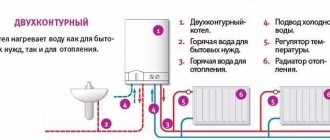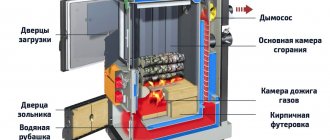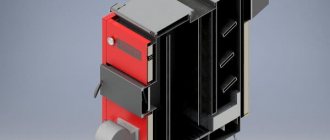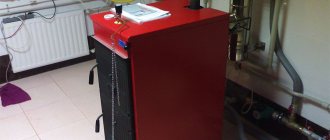Modern boilers are equipped with advanced control systems that allow the units to function normally without human intervention. This is very convenient from an ergonomic point of view, as it allows you to configure the necessary operating parameters once and never return to this point.
Automation for solid fuel boilers is distinguished by its functionality and the number of available options. The more expensive the model, the more advanced it will be and will allow you to set all operating parameters as accurately as possible. Often, expensive boilers are sold immediately together with the control unit. But you can also agree on installing non-native automation. To do this, you need to talk to the manager who will process the order.
Benefits of automatic control
Computerized control systems are being introduced into all devices. This allows them to increase their productivity and frees people from repetitive routine actions. The automation kit for a solid fuel boiler includes a main computer for control and a fan turbine. This allows you to significantly increase the efficiency of the unit, increase the efficiency of fuel combustion and minimize the loss of thermal energy during transportation.
In this case, the system will always maintain the set temperature. The boiler will not boil due to excess fuel, but the pipes will not cool either. Boiler automation helps improve burnout of wet fuel by 35%. Thus, there will be one third less unburned residues. This will allow the use of any solid waste and fossil resources as fuel.
Today, the best automation for solid fuel boilers is Atos. It is equipped with high-quality components and copes well with all technological operations. There are a large number of models on sale that are designed for boilers with different rated power.
When purchasing, it is very important to compare the technical characteristics of the automation and the boiler so that they are compatible with each other. The package includes high-precision sensors for monitoring temperatures in different compartments of the boiler. They will help maintain an optimal level of combustion, and will also allow the most efficient distribution of thermal energy throughout the system.
Rules for organizing solid fuel heating
The main difference that a heating system with a closed-type solid fuel boiler has is the type of fuel used. Coal, firewood, peat or fuel briquettes are used as energy carriers. All of them are characterized by high energy intensity and, as a result, intense heat release.
In order to make heating with a solid fuel boiler with your own hands, you will need to familiarize yourself with the rules of its organization. They directly depend on the chosen scheme, the pipe distribution system and the coolant used.
A characteristic feature is the correct installation of heating with a solid fuel boiler. The source of thermal energy and fuel must be located in different rooms, and in addition to the installation rules, safety measures for the operation of heating must be observed.
The basic rules for the design and practical implementation of heating systems using solid fuel boilers and stoves are the following:
- Use of non-combustible materials. When installing a stove or boiler, the floor, walls and ceiling in the chimney area must be fireproof. Those. if exposed to high temperatures, these materials should not spontaneously ignite or smolder;
- Work stabilization. The main danger when operating a solid fuel boiler for water heating is overheating of the water in the heat exchanger. To prevent this, the boiler or stove provides the ability to regulate the air supply necessary to maintain the combustion process of wood. This could be a system of valves connected to a mechanical temperature controller;
- Supply and exhaust ventilation. The classic installation scheme for heating from a solid fuel boiler provides for air exchange in the room where the equipment is installed. When it operates, combustion products will inevitably enter the room. Supply and exhaust ventilation will remove them, thereby preventing CO2 concentrations that are dangerous to humans.
Factory-made or home-made solid fuel heating boilers should be installed in separate boiler rooms. Exceptions are models with low power, which are equipped with a hob. But even in this case, all safety measures must be ensured in the kitchen.
The basic rules for arranging boiler rooms in which double-circuit solid fuel heating boilers will be installed are described in SNiP II-35-76. Before installing the equipment, you should read this document.
Features of installing automation on the boiler
The installation of automation on a solid fuel boiler should be carried out by a professional technician. The procedure has quite a few nuances that must be taken into account. Incorrect installation will make it impossible for the unit to function normally and all efforts to replace the control unit will be in vain. The cost of the service is very low, so you won’t be able to save a lot of money on this. But the damage from incorrect actions and subsequent breakdown will be noticeable.
After completing installation work, correct calibration must be carried out. You can do this yourself using the included instructions, or seek help from the specialist who carried out the installation. The automation for the boiler is configured according to the following scheme:
- 1. First, you need to fill the heating system with coolant and bleed all the air out of it so that there are no plugs that will interfere with normal circulation. It won't be difficult at all to do this.
- 2. Then you need to start the circulation pump and check that it begins to drive water through the system without any obstacles.
- 3. When the water in the system begins to circulate, you need to check the readings on all emergency thermostats, as well as the water level and its pressure in the system. All indicators must be within acceptable limits.
- 4. Now you can proceed directly to ignition. Each automation has its own characteristics of starting the flame into the combustion chamber, so at this stage you must strictly adhere to the requirements of the operating instructions.
- 5. When ignition is completed, you need to add the specified amount of fuel into the firebox and set the desired operating parameters. Occasionally you will need to add fuel and check the readings of control devices with the norm.
Wall unit electronics
A special feature of these heat generators is electronic control of the processes of ignition, combustion and maintenance of coolant temperature. That is, wall-mounted gas boilers (and some floor-standing ones) are equipped with energy-dependent automation powered by electricity.
An automatic gas boiler was created for maximum convenience for owners of apartments and private houses. To start the heater, just press 1 button and set the desired temperature. Let us briefly describe the operating algorithm of the unit and the elements involved in it:
- After these startup steps, the heat generator controller collects sensor readings: coolant and air temperature, gas and water pressure in the system, and checks the presence of draft in the chimney.
- If everything is in order, the electronic board supplies voltage to the electromagnetic gas valve and at the same time a discharge to the ignition electrodes. The wick is missing.
- The main burner ignites and gives full power in order to heat the coolant as quickly as possible. Its operation is monitored by a special flame sensor. The controller includes a built-in circulation pump.
- When the coolant temperature approaches the set threshold, which is recorded by the overhead sensor, the combustion intensity will decrease. Staged burners switch to low power mode, and modulating burners smoothly reduce the fuel supply.
- Having reached the heating threshold, the electronics will shut off the gas. When the sensor detects cooling of the water in the system, automatic ignition and heating will be repeated.
The instructions for the wall-mounted gas boiler indicate that the unit is designed to operate in a closed heating system, so the automation monitors the water pressure. If it drops below the permissible limit (0.8-1 Bar), the burner will go out and will not light until the problem is corrected.
Many imported boilers operate according to an energy-dependent scheme, for example, Buderus Logano, Viessmann and so on. How the installation of electronic gas equipment occurs, the master will tell you in an accessible language in the video:
Watch this video on YouTube
What are the differences between mechanical automation and electronic automation?
Mechanical automation for solid fuel boilers is much simpler and cheaper than electronic automation. Its functionality is limited to the ability to open and close the air duct into the combustion chamber. The rate of fuel burning and the heat in the firebox will depend on this. Structurally, the product is a brass sleeve with a plastic handle and a chain that controls its movement.
The movement of the sleeve will be regulated by the temperature of the water in the system. This makes the automation completely independent of the power supply, so that in terms of reliability it is ahead of the computerized model. This type of automation can be installed independently without any problems, since it requires literally two steps.
The price of automation for a solid fuel boiler depends on its technical capabilities. The simplest mechanical models will cost 1,500 rubles. And the most “smart” automated control systems will cost more than 20 thousand rubles. But the feasibility of the purchase is undeniable, since in addition to increasing the ergonomic level of the boiler, automation also allows you to save a decent amount of money due to more efficient consumption of resources.
But today boilers have begun to be produced in more modernized ways. Now a person will not have to constantly hover around the boiler to throw in a couple of firewood or take out the ashes, nor will he have to check the temperature. The boiler does all this itself, regardless of the person, since now they have automation. This means that a person can only configure the automation as desired, and then he can not interfere with the operation of the boiler. Automation for solid fuel boilers includes a computer for control, as well as a fan turbine, which increases efficiency.
Types of control units
The units are either electronic or mechanical.
The electronic version is considered more efficient, but is characterized by energy dependence.
Mechanical, on the contrary, is energy independent. It does not require connection to the electrical network and is cheaper. At the same time, it is reliable and easy to use.
When choosing, you need to pay attention to the following important parameters:
- compatibility of the unit with a specific boiler model;
- thermal operating mode;
- economic efficiency;
- required degree of temperature level adjustment.
Advantages and disadvantages
Automation for solid fuel furnaces has a large number of advantages, and only one drawback. They will be discussed below.
So, the advantages:
- Automatic temperature adjustment. Previously, a person had to set the damper at the right level to increase and decrease the temperature in the boiler. Now, modern solid fuel stoves will take care of this themselves. A person only needs to adjust the temperature and that’s it! During operation, the boiler will check the temperature and, using special devices such as a fan or pump, will limit or increase the air supply. If the temperature inside the boiler rises, the air supply is automatically limited, and if the temperature is below the set norm, the air supply is increased.
- Independent operation of the boiler. Previously, if the owner needed to go somewhere for several days, he had to completely turn off the boiler, that is, take it out of the operating phase. With modern units everything is different. Thanks to automation, you can set the minimum parameters for the stove before leaving, and when you arrive, the house will be warm and cozy.
- Ignition of fuel. Now there is no need to ignite the fuel. The system will do this automatically.
- Safety. Modern units have the highest level of safety. The system is equipped with special devices that are capable of detecting the breakdown or failure of one or another element. This will be indicated by a sharp jump in temperature, change in pressure, etc. If this is detected, the system automatically stops operation and makes a sound, so the owner can quickly find out about the malfunction and call a specialist.
- Electricity reserve. If the power supply is suddenly interrupted, the unit will continue to operate for some time.
- Self-loading of fuel. Modern boilers have a special tank in which firewood or other types of fuel are stored. Automation is capable of automatically loading fuel into the combustion chamber. Now the ash pan is also cleaned automatically without human intervention.
- Control system. There are types of automation where a person, by clicking on special screen elements, must set certain values. But there are also options where a person does not need to approach the system and can simply control the remote control, and the signal is picked up at a fairly large distance.
These are the advantages of automation. It must be said that all this is aimed at making human life as comfortable as possible and the boiler as safe as possible. Automation has only one drawback - energy dependence.
Design and operating principle
The automation that controls the operation of a gas boiler consists of many elements, conditionally divided into two subgroups. The first includes mechanisms that ensure the full and safe functioning of the boiler itself. The second includes devices that make it possible to operate the heating system in the most convenient and user-friendly mode.
Components of a security system
Several modules are responsible for the operational safety of the unit:
Flame controller - consists of two main parts - a solenoid valve and a thermocouple. Shuts off gas promptly and reliably and prevents leakage.
Thermostat - maintains the set coolant temperature and protects the system from overheating
When the coolant cools down to minimum temperatures, the module starts the boiler into operation, and after recording peak-high readings, it turns it off, completely relieving the owners of the need to constantly pay attention to the system.
The draft control sensor is responsible for stopping the gas supply to the burner in the event of a change in the basic position of the bimetallic plate, thus preventing gas leakage.
Safety valve - monitors the amount of coolant in the circuit.
Strapping scheme
A solid fuel unit is usually connected to a boiler that runs on a different type of fuel. This is usually an electrical unit.
An electric one is installed parallel to the solid fuel stove. This is the so-called auxiliary element. Its role is as follows: if, for example, the owners are not in the house for a long time, and the solid fuel boiler has run out of fuel, then the auxiliary element, in this case, the electric unit, automatically comes into working condition. It maintains positive temperatures. More on how it all works.
First, the coolant under pressure from the circulation pump is supplied to the boiler, passing through which it heats up. Next, the coolant enters the radiator, where movement follows the principle of natural circulation. Then it enters a special boiler, inside of which there is a coil that is immersed in water. The coolant, passing through the coil, heats it, as a result of which the water heats up. Thus, the residents of the house are provided with hot water.
After the boiler, the coolant again enters the radiators and underfloor heating coils. But before that, he must pass a special crane. If the temperature of the coolant corresponds to the established norm, then the tap opens and the coolant circulates through the floor coils, and if the temperature is higher than normal, the tap closes.
Types of automation
Depending on the operating principle and design features, automation for gas heating boilers can be one of the following types:
:
- Volatile.
- Non-volatile.
Energy-dependent automation devices
These devices are small electronic devices that respond to the gas supply by opening/closing a tap. The device is structurally complex.
Problems that electronic boiler automation allows you to solve
:
- Close/open the gas supply valve.
- Start the system in automatic mode.
- Adjust the burner power thanks to the presence of a temperature sensor.
- Turn off the boiler in emergency cases or within the specified operating mode.
- A visual demonstration of how the unit works (what temperature is maintained in the room, to what point the water is heated, and so on).
Electronic boiler automation
Due to the constant growth of consumer demands regarding ease of use, manufacturers of modern devices offer a number of additional features:
- Management and control of equipment operation.
- Protection of the heating system against malfunction of the three-way valve.
- Protection of the system from freezing. In this case, the device starts the boiler when the room temperature drops sharply.
- Self-diagnosis in order to identify faulty spare parts and malfunctions of structural elements. This option allows you to avoid breakdowns that could disable the boiler, and, consequently, large material costs associated with major repairs or replacement of equipment.
Thus, electronic safety automatics for gas boilers ensures smooth operation of the equipment when:
- no jumps;
- the specified temperature regime is strictly observed;
- no other problems arise during long-term operation.
Today, the market offers a wide range of energy-dependent automation. It can be either with or without programming capabilities. In the first case, you can configure the system to operate in day-night mode or set different temperature conditions for days 1-7, taking into account the weather forecast.
Non-volatile devices
This type of automatic equipment for controlling the operation of gas heating boilers is mechanical. And many consumers prefer it.
Main reasons
:
- Low price.
- Manual setup, characterized by simplicity, makes it easy for people who are far from technology to operate the device.
- Autonomous device that does not require electricity to operate.
Manual setup is as follows
:
- Each device is equipped with a temperature scale from minimum value to maximum value. By selecting the desired mark on the scale, you set the operating temperature of the boiler.
- After starting the unit, the thermostat takes over, controlling the set temperature by opening/closing the gas supply valve.
Manual regulator for heating boiler automation
The principle of operation is based on the fact that the gas boiler thermocouple, which is built into the heat exchanger, is equipped with a special rod. The part is made of a special material (an alloy of iron and nickel - Invar), which quickly responds to temperature changes. Depending on the increase or decrease in temperature, the rod changes its size. The part is firmly connected to the valve, which regulates the gas supply to the burner.
But besides this, today’s automation for a non-volatile gas boiler is additionally equipped with draft and flame sensors. They will immediately stop supplying fuel if there is a sharp drop in draft in the chimney or as a result of a decrease in pressure in the pipe.
A special thin plate is responsible for the operation of the flame sensor, which is in a bent state during normal operation of the system. This keeps the valve in the “Open” position. As the flame decreases, the plate straightens, causing the valve to close. The same principle of operation applies to the traction sensor.
Installation. Step-by-step instruction
The installation of automation should be carried out by a professional who knows his business. This process is very complex and hides a large number of nuances that must be taken into account. There is no need to skimp on the services of an installation specialist; it is already inexpensive.
If you take on this work yourself, then there is a big risk of making mistakes, for which you will have to pay for them in material resources many times over, since you will have to replace most of the boiler elements.
- The first thing specialists usually do is install a ventilation system. It is usually installed at the bottom of the boiler, where the damper is located. First, the damper is removed, then the fan is installed. It must be secured with four fasteners.
- The next step is to install the controller. The controller is a control unit. Specialists install it in the upper part of the boiler. But it can also be installed on the side.
- Then the automation is configured. Setting up the automation will be discussed in more detail below.
- The system is then connected to a power source and tested. There may also be many other options depending on the manufacturer.
Installation and configuration
The installation process of an automatic control system includes:
- Connection of the blower fan. As a rule, the turbine is located on the lowest door of the boiler, where the damper is located. But there are models of units where it is installed on the side wall, or in a special place on the top of the boiler, it all depends on the design features. Everything is simple here: the damper is removed, and a fan is put in its place; four bolts are used for fastening. If there are no holes for mounting, they need to be drilled. For fans with a damper, installation is carried out in such a way that the damper is closed when the fan is off.
- Installation of the controller. First of all, you need to decide on the place where the device will be installed. The main requirement is that it should not heat up. On models without a hob, the automation is mounted on top. If the design of the unit allows, you can install the unit on the side wall. Don't forget about the length of the cables.
- Connecting the temperature sensor. A correctly installed temperature sensor will ensure the normal functioning of the entire control unit. If the model does not have a special place for the sensor (hole parameters: diameter 10 mm, depth 60 mm), then it can be mounted on the output metal pipe. A clamp is used as a fastening material; it can be supplied with the device.
- Connecting connectors. To do this, you need to connect the turbine connector to the control unit connector. Finally, you need to connect the device’s network cable. The automation is ready to perform its functions.
How to setup
As a rule, all devices have instructions from the manufacturer, which detail step-by-step instructions on how to set up a newly installed device.
In general, all steps boil down to the following points:
- First, the heating system must be filled with coolant. At the same stage, the presence of air cavities inside the system is checked. They shouldn't exist.
- Now the circulation pump is activated. Here you need to make sure that it adjusts the coolant without any obstacles.
- After the circulation pump is started, it is necessary to check the thermostat indicators, where temperature and pressure indicators will be given. All these indicators must be within the limits established in the instructions.
- If all indicators are normal, then you can start ignition. Here you should fulfill all the requirements specified in the instructions without exception, since automation devices from different manufacturers release flames into the combustion chamber in completely different ways and have a number of their own characteristics.
- When everything is completed, you should throw a certain amount of fuel into the firebox (this amount is usually indicated in the instructions) and set the necessary parameters. It is recommended to add fuel several times and check the instrument readings to ensure they do not go beyond normal limits.
Functions and principle of operation of security automation
According to regulatory documentation, the safety system of automatic gas boilers must consist of equipment that will turn off the system, shutting off the gas in the event of any breakdown. Thus, automation monitors a number of indicators
:
- Gas pressure. When it drops to a critical point, the fuel supply stops. The action occurs automatically due to the valve mechanism, which is set to a certain value. In volatile devices, the maximum/minimum pressure switch is responsible for monitoring. The membrane with the rod bends as the number of atmospheres increases, as a result of which the boiler power contacts open.
- Is there a flame in the burner? In its absence, the thermocouple cools down, stopping producing current. As a result, the gas valve solenoid valve does not work and gas is not supplied.
- Presence of traction. When it decreases, the bimetallic plate heats up and changes shape, so the valve stops the fuel supply.
- Coolant temperature. The thermostat is necessary to maintain the temperature set by the user, preventing the system from overheating.
Schematic diagram of the operation of the automation regulator
The result of these malfunctions may be the main burner turning off and the room becoming gassed, which is absolutely not allowed. Therefore, automation must be present on all gas boilers without exception, especially on old-style equipment, where this design was not provided by the manufacturer.
The functioning of the electronic system is based on receiving information from sensors. It is analyzed by the controller and microprocessor. After processing the data, certain commands are sent to the drives of the unit.
The operating principle of the mechanics is different. When the boiler is switched off, the gas valve is closed. Starting the unit involves squeezing the washer on the valve, as a result of which it opens in forced mode and fuel flows to the igniter. Its ignition leads to heating of the thermocouple and the generation of voltage on it necessary for the operation of the electromagnet. He, in turn, keeps the valve open. By turning the washer, you can adjust the boiler power.
Estimated cost
Different manufacturers have different prices and characteristics of automation devices.
Among domestic manufacturers, there are two companies that are quite popular in the market:
- Start. The automation of this company operates on an ATOS unit. Power reaches 40 kW. The cost of the unit is 6,000 rubles, and the cost of the temperature controller is 2,500 rubles.
- Virbel. The automation from this company costs a little less – 2,500 rubles.
Strange as it may sound, in our age of scientific and technological progress, solid fuel boilers still remain in demand and are even considered practically the most common heating devices. And if there is demand, then there will be offers - not only for the boilers themselves, but also for various devices designed to optimize their operation. One of such devices is automation for solid fuel boilers, which allows you to very effectively control the operation of the boiler, simplify its maintenance and operation. We will talk about how it works and on what principle it works in this article - in addition, together with the website stroisovety.org we will talk about how to independently automate the operation of a boiler that burns solid fuel.
Automation kit for solid fuel boilers photo
The best known manufacturers and models: characteristics and prices
ATOS + WPA 120
One of the best and most common automation kits for solid fuel heating boilers.
The ATOS controller is distinguished by extremely wide functionality, a considerable number of customizable operating parameters and an affordable price. In addition to standard functions, there is: protection against freezing of the heating system; notification of temperature drop or overheating, lack of fuel; LED indicators of circulation pump and fan operation; adjustable hysteresis. It is also known for its reliability due to operational practice. Manufacturer: KOM-STER, Poland.
Blower fan M+M WPA 120 is also the most common, time-tested Polish model. Designed to work with boilers with a power of 25-50 kW. There are other versions on the market for more or less powerful boilers.
Cost of the set: 8,900-10,000 rubles.
COMFORT-ECO + NWS-100
The controller is another Polish model: with almost the same functionality and reliability for an even more modest price. Functionality implies the presence of all safety functions, the ability to connect a room thermostat and outdoor sensors, control of a circulation pump (but not DHW). It features a fail-safe filter and an overload fuse.
The Nowosolar NWS-100 turbine is a simple Polish aluminum model, one of the most inexpensive on the market. It has an unremarkable standard design, known for high-quality assembly and reliability. The model is designed for installation in boilers with a power of 30-50 kW.
Cost of the set: 8,500-9,800 rubles.
Tech ST24 + WPA 120
The controller is a hassle-free, simpler model, equipped only with standard functions: control of the boost fan speed, control of the circulation pump, LED indication of the operation of the elements. Installation of external sensors and automatic feeding systems is also not provided. An excellent choice, but at a price comparable to more functional models. The fan is the most common model already described above.
Cost of the set: 9,200-10,500 rubles.
KG Elektronik CS-18S + DP-120
The Polish controller KG Elektronik CS-18S is one of the most modern and functional on the market. It is distinguished by the presence of a touch screen control, the ability to control the fan, circulation pump, hot water supply, and automatic supply system. The DHW pump can be made a priority; there are also special modes adapted for each type of fuel: wood, wood and coal, coal, sawdust. All existing protective mechanisms are also provided: against overheating and freezing, stopping the circulation pump.
The KG Elektronik CS-18S + DP-120 fan is also one of the best. It features an asynchronous motor and high performance with a relatively low noise level of up to 63-65 dB. It has a metal damper at the outlet that blocks the reverse flow of exhaust gases.
Cost of the set: 11,000-12,500 rubles.
Automation for solid fuel boilers: combustion control principle
At first glance, it may seem that controlling the element of fire (even placed in a confined space) is very difficult, but in fact this is not the case. Remember what affects the combustion intensity of solid fuel - that’s it, oxygen, which is supplied to the boiler through the ash pan. Consequently, you can control the operation of the boiler by opening and closing the vent - yes, this is not very convenient and not very practical, but who says that you can’t come up with an alternative? It’s very possible - all you need to do is install an electric fan in the vent door. And people can control its rotation speed very effectively.
Thus, modern automation for a solid fuel boiler fan has the following form.
- Blower fan. As a rule, it is installed either in the blower door, or a separate hole is designed for it.
- A special controller is used to control the fan speed.
- Adequate operation of this controller is guaranteed by a thermostat, the sensor of which is mounted in the heating supply pipe.
Automation for solid fuel boiler fan photo
The required coolant temperature is set on the controller - when the water in the system heats up to the set point, the sensor is triggered and the automation turns off the fan. Oxygen stops flowing into the boiler firebox, causing the fire to die out. And, conversely, as soon as the coolant temperature drops below a certain value, the same sensor sends a signal to the controller, which starts the fan - an abundant amount of air in the firebox ignites the flame with renewed vigor. Everything is simple, and the most important thing is that the person will not forget to cover the vent, thereby bringing the boiler to a boil.
Advantages and disadvantages
Advantages of use:
- when burning firewood, it is impossible to obtain such a high temperature as during the combustion of pyrolysis gas (especially if the firewood contains a lot of moisture);
- With the help of a control controller, we can automate the operation of a pyrolysis boiler without much difficulty, since the combustion process of pyrolysis gas is easy to control and regulate;
- burning wood or coal requires much more secondary air than burning wood gas. Therefore, with the same volume of secondary air, the combustion efficiency of wood gas, the duration and temperature of combustion will be greater;
- the emission of harmful substances from pyrolysis boilers into the atmosphere is reduced to a minimum, therefore a pyrolysis boiler is an almost environmentally friendly source of heat;
- solid fuel pyrolysis combustion boilers need to be cleaned from ash extremely rarely;
- pyrolysis boilers can operate for a very long time (up to 15 hours) on one load of firewood, while conventional solid fuel boilers need to be reloaded every 3-4 hours.
If we talk about the disadvantages of this type of unit, then, in addition to the price, which is the price for increased efficiency, and a more complex design, because pyrolysis boilers are 30-35% heavier than conventional ones, since more metal is required for their manufacture, other “disadvantages” insignificant.
For maximum operating efficiency, the moisture content of firewood should be no more than 20%. If the wood is wet, when it burns, steam is generated, which reduces gas emissions and leads to the deposition of tar and soot. As a result, the efficiency of the boiler decreases, and there is a need to clean it.
Most pyrolysis units are electronically controlled.
Consequently, it becomes necessary to use electricity to operate the controller, which controls the fan and smoke exhauster.
Pyrolysis boilers with natural draft exist, but they require a very high and powerful chimney, so such models are unpopular.
The need to fill the firebox by 50-100% - only in this case will the high efficiency of the boiler be maintained.
Long-burning pyrolysis solid fuel boilers, although twice as expensive as a conventional solid fuel boiler, are distinguished by the possibility of economical use of fuel with maximum efficiency, which is significantly higher than from the combustion of coal and wood in conventional units.
Advantages provided by an automation kit for a solid fuel boiler
There are no accidents or coincidences in our world, and people had to automate the process of burning solid fuel in a heating boiler for a reason - there are a number of good reasons for this. The most important of them is safety. Anyone who uses solid fuel to heat a home probably knows the consequences of overheating the coolant - boiling water in the boiler can even lead to an explosion with serious consequences. First of all, automatic control allows you to control exactly this moment - a person is a forgetful creature by nature, and automation works according to a program, and there is no such thing as “forgetting” for it.
Types of pyrolysis boilers with a water circuit
There are many models on the market that can be divided into groups.
- The location of the chamber in which the contents are burned.
Most boilers are designed so that this compartment is located at the bottom. This is more convenient for laying the material, but after its combustion, the ash enters the chamber where the resulting gas burns.
This obliges the owner to frequently clean the equipment. The top location of the camera eliminates this need, but has a number of disadvantages. The main disadvantages of such a system include the inconvenience of placing the chimney and the larger amount of materials for its manufacture.
- Traction type.
It can be carried out either by force or by supercharging. Boilers in which the draft power can be manually adjusted require the installation of a reinforced chimney and do not depend on the power supply. Such models are few and far between.
Devices of the second type are equipped with automatic systems that determine the blowing time. Maintaining power requires the energy dependence of the unit, but the rate of pyrolysis output in it is quite high. These models are the most popular.
- Type of fuel.
When determining the possibility of using a particular type of fuel, one should start from the moisture level of the material. If it is higher than 20%, then the first operating time of the boiler will be spent drying the material, which leads to a decrease in the efficiency of the device.
If the humidity of the fuel used is initially high, then the pyrolysis process will take no more than 1/5 of the entire combustion cycle. This is extremely ineffective and irrational.
It will be difficult to recoup the high cost of the boiler. Therefore, the conclusion is obvious: the best material for combustion in pyrolysis boilers is firewood, coal or briquettes, the moisture level of which is minimal.
Each material has its own burning time. The smoldering time determines the quality and uniformity of heating of a living space. The best option is dry wood with a moisture level of no more than 10–15%.
Today, there are two main types of pyrolysis units, differing in design.
- Boilers with forced air supply.
In the first version of the boiler design, the primary combustion chamber, where solid fuel is placed, is located above the secondary combustion chamber, where afterburning of pyrolysis gases is organized. A special nozzle is installed between the chambers, having a straight cross-section and made of a refractory composition similar to fireclay bricks.
In this design, air is forced into the main firebox using an installed fan, and partly enters the firebox with solid fuel, and partly into the afterburning chamber of the released gases.
In this case, it is obvious that the principle of pyrolysis is violated initially, since the fan creates an excess of oxygen instead of limiting it.
But, despite this, efficient and complete combustion of firewood occurs, with virtually no residue of even fine ash, since dry wood or products based on it burn to fine ash, and it is easily blown out through the nozzle by a fan into the chimney pipe.
Knowing the features of this design, it can be called a “top blowing device”, since the air pumped by the fan enters mainly into the upper main combustion chamber.
Due to the influx of oxygen, the temperature during combustion increases and gas production increases, but it burns quite quickly, escaping through the nozzle.
In this regard, firewood quickly burns out, and it has to be added quite often in the process of heating the house. This principle of boiler operation cannot be called pyrolysis in the full sense of the word, although similar devices are sold quite often under this name.
It’s another matter if the fan standing on the outlet pipe (often called a “smoke exhauster”) creates air movement, which is proportionally divided into primary and main - secondary using the usual mechanical method or using automation.
In this case, the primary air damper is located so that it is supplied precisely to the lower part of the fuel filler.
The smoldering of firewood occurs from below, and the temperature released during this process promotes heating - in the middle layers of the stack, and final drying - in the upper ones.
The main air flow will be supplied only to the nozzle area, so that the final combustion of the pyrolysis gases with the maximum amount of heat generated takes place in the lower chamber. Such a boiler can rightfully be classified as a long-burning pyrolysis boiler.
- Boiler with natural air supply.
In such a boiler design, the combustion chamber for storing firewood is located in the lower part of the device, and the combustion section of the pyrolysis gases released by the fuel is in the upper area of the body.
A fan is not installed in this design, and the air for lighting the boiler and afterburning pyrolysis gases is supplied naturally through dampers for primary and secondary air.
In this version of the arrangement of the chambers and the dosed supply of air flows, the pyrolysis process is carried out properly, since instead of intense combustion, with the primary air supply damper closed, wood smoldering occurs in the combustion chamber with the release of a large amount of pyrolysis gases.
However, this design also has its own problem. And it lies in the fact that the correct debugging of the combustion process is extremely important.
When the main chamber damper is completely closed, the temperature in it decreases, as well as the formation of gases. The concentration and temperature of the gases becomes insufficient for their complete afterburning and the upper chamber turns into a regular gas outlet.
The combustion products that rise into it do not burn out, but simply give off heat to the walls of the water circuit and go into the chimney. The efficiency of the boiler during such operation is sharply reduced. If the damper is opened more than required to create the conditions necessary for pyrolysis, then the intensity of combustion in the main firebox will increase, which leads to completely irrational fuel consumption and the need for frequent refills.
To achieve ideal operation of a pyrolysis boiler of this design, it is necessary to correctly adjust the supply of primary and secondary air, which is quite difficult to do, since this requires practical experience.
Modern models have automated process monitoring and control systems, and if the automatic fuel loading system works correctly, it lasts for 12-14 hours of operation at maximum heat transfer.
Automation scheme for solid fuel boilers: expanding possibilities
Man has learned best to control electricity - it is electrical signals and impulses that are used to control everything that is needed, including other equipment involved in the operation of the heating system.
- Heating circulation pump. Automatic control allows for constant and, most importantly, uniform distribution of heat throughout all rooms of the house.
- Circulation pump for domestic hot water. At a minimum, this is control of the water temperature, and at a maximum, it is supplied on a schedule, which, again, allows you to effectively manage the received heat.
- Water temperature in the boiler. The most important thing here is to prevent overheating and prevent the consequences of this.
Automation for solid fuel boilers: diagram
And that’s not all - modern automation for a solid fuel boiler can do many different things. For example, it allows you to program it, so to speak, remotely, using a GSM module. It is also possible to program the heating operation daily, daily and even hourly. By and large, correctly selected automation for a solid fuel boiler even makes it possible to integrate it into a global smart home system.
The principle of operation of volatile and non-volatile heating systems
All devices installed to control the operating processes of the system are divided into volatile (electronic) and non-volatile (mechanical).
Mechanical ones are cheaper, are very simply designed and do not require electricity. The basic principle is to change the size or position of a structural element that is sensitive to changes in temperature or pressure. In accordance with this, the gas supply, coolant flow intensity, and other system operating parameters are reduced or increased.
Volatile automatic devices are controlled by a microprocessor, the valves are activated based on data processing.
The system operating modes required by the user are set on the device display.
Reference! Electronic devices can be duplicated with mechanical ones, then a breakdown in the electronics will not affect the operation of the heating device. This is especially true if there are long periods without light.
How to make simple automation with your own hands: tips and tricks
It’s not difficult to set up the simplest automatic control of a solid fuel boiler with your own hands. The most important thing here is to buy the right equipment. You understand that you will not be able to make all the necessary devices, and the equipment itself, by and large, does not cost that much. That is why, when talking about homemade automation for a solid fuel boiler, in most cases we mean buying ready-made equipment and installing it yourself. Do-it-yourself installation is quite simple, and you can imagine this whole process in the form of the following sequence of work.
- Fan installation. This is the most difficult part of the work, especially if the boiler design does not provide for automatic control. In such a situation, you will have to make a hole for air injection yourself and install a turbine on it. In principle, this is not difficult for a technically competent person - the main thing here is not to forget about the heat-resistant seal between the fan and the door, and everything else is trivial. The fan is screwed into place through pre-drilled holes in the blower door.
- Connecting the controller. There is also nothing complicated here - when purchasing an automation kit, you are buying some semblance of a construction set, which is assembled according to the scheme. No exception is the switching of wires, which, among other things, are equipped with connectors that cannot be confused.
When the automation is assembled, there is only one thing left to do - install a temperature sensor. As a rule, in almost all models of modern solid fuel boilers a special place is provided for it. If this is not available, then you can attach the sensor directly to the supply pipeline - in the simplest version, this is done using metallized heat-resistant tape. The sensor is simply wound onto the pipe.
Homemade automation for a solid fuel boiler photo
This concerns the electronic control of a solid fuel boiler. But besides this, there are also mechanical systems that regulate the intensity of fuel combustion by simply opening and closing the boiler ash door. How such automatic control works is, one might say, quite simple. A mechanical thermoelement is installed in the boiler (in a specially designated place) - when heated, the plate built into it changes its shape and configuration, which sets a special lever in motion. In turn, this lever is connected to the ash door by a cable or chain, which transmits the movement of the lever directly to the door, as a result of which it opens and closes, depending on the temperature of the coolant in the boiler.
Which automation is better for solid fuel boilers? Mechanical or electronic? Both principles of controlling fuel combustion in a boiler have their drawbacks. Electronic systems do not work without electricity - in order to ensure the operation of the boiler during power outages, you will additionally have to purchase an uninterruptible power supply unit. The mechanics often jam. In addition, the choice of one or another automation system for a solid fuel boiler can also be influenced by its cost - mechanics will cost less.
Connecting the thermostat
When connecting a conventional thermostat to the boiler (as an element of automation), operating comfort increases and gas consumption is reduced. This occurs due to the fact that the boiler is controlled by a sensor installed in the thermostat itself and turns off the burner when the set air temperature is reached in the room.
Taking into account the fact that the volume of air in the room is several times (or even tens of times) greater than the volume of the coolant, its cooling rate is several times lower than the rate of temperature drop in the boiler.
However, in this operating mode it is impossible to adjust the coolant temperature using the thermostat itself. Therefore, the value on the boiler is most often set to the calculated maximum. This is done to ensure that the boiler reaches the set temperature as quickly as possible. However, this method has one negative side. The media temperature either rises to maximum or drops almost to room temperature during idle time. During the off-season, this can lead to uncomfortable sensations. The radiator is either cold or hot - this is not very convenient.
